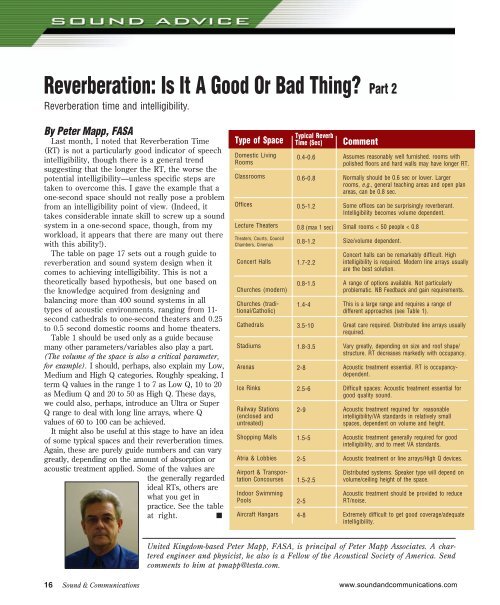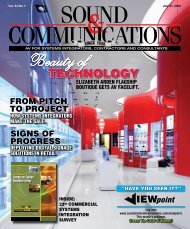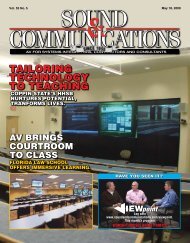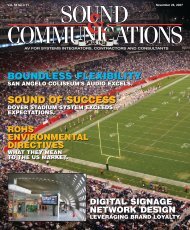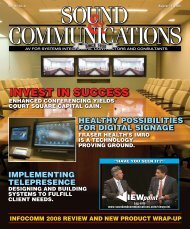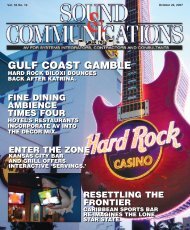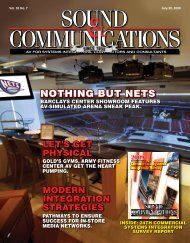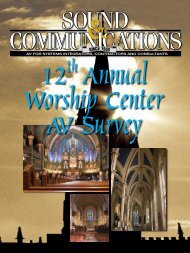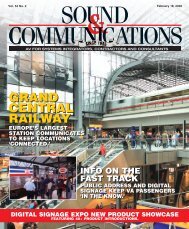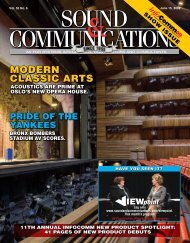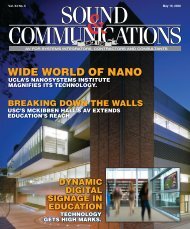Sound & Communications April 2008 issue
Sound & Communications April 2008 issue
Sound & Communications April 2008 issue
- No tags were found...
You also want an ePaper? Increase the reach of your titles
YUMPU automatically turns print PDFs into web optimized ePapers that Google loves.
Reverberation: Is It A Good Or Bad Thing Part 2<br />
Reverberation time and intelligibility.<br />
By Peter Mapp, FASA<br />
Last month, I noted that Reverberation Time<br />
(RT) is not a particularly good indicator of speech<br />
intelligibility, though there is a general trend<br />
suggesting that the longer the RT, the worse the<br />
potential intelligibility—unless specific steps are<br />
taken to overcome this. I gave the example that a<br />
one-second space should not really pose a problem<br />
from an intelligibility point of view. (Indeed, it<br />
takes considerable innate skill to screw up a sound<br />
system in a one-second space, though, from my<br />
workload, it appears that there are many out there<br />
with this ability!).<br />
The table on page 17 sets out a rough guide to<br />
reverberation and sound system design when it<br />
comes to achieving intelligibility. This is not a<br />
theoretically based hypothesis, but one based on<br />
the knowledge acquired from designing and<br />
balancing more than 400 sound systems in all<br />
types of acoustic environments, ranging from 11-<br />
second cathedrals to one-second theaters and 0.25<br />
to 0.5 second domestic rooms and home theaters.<br />
Table 1 should be used only as a guide because<br />
many other parameters/variables also play a part.<br />
(The volume of the space is also a critical parameter,<br />
for example). I should, perhaps, also explain my Low,<br />
Medium and High Q categories. Roughly speaking, I<br />
term Q values in the range 1 to 7 as Low Q, 10 to 20<br />
as Medium Q and 20 to 50 as High Q. These days,<br />
we could also, perhaps, introduce an Ultra or Super<br />
Q range to deal with long line arrays, where Q<br />
values of 60 to 100 can be achieved.<br />
It might also be useful at this stage to have an idea<br />
of some typical spaces and their reverberation times.<br />
Again, these are purely guide numbers and can vary<br />
greatly, depending on the amount of absorption or<br />
acoustic treatment applied. Some of the values are<br />
the generally regarded<br />
ideal RTs, others are<br />
what you get in<br />
practice. See the table<br />
at right. ■<br />
Type of Space<br />
Domestic Living<br />
Rooms<br />
Classrooms<br />
Offices<br />
Lecture Theaters<br />
Theaters, Courts, Council<br />
Chambers, Cinemas<br />
Concert Halls<br />
Churches (modern)<br />
Churches (traditional/Catholic)<br />
Cathedrals<br />
Stadiums<br />
Arenas<br />
Ice Rinks<br />
Railway Stations<br />
(enclosed and<br />
untreated)<br />
Shopping Malls<br />
Atria & Lobbies<br />
Airport & Transportation<br />
Concourses<br />
Indoor Swimming<br />
Pools<br />
Aircraft Hangars<br />
Typical Reverb<br />
Time (Sec)<br />
0.4-0.6<br />
0.6-0.8<br />
0.5-1.2<br />
0.8 (max 1 sec)<br />
0.8-1.2<br />
1.7-2.2<br />
0.8-1.5<br />
1.4-4<br />
3.5-10<br />
1.8-3.5<br />
2-8<br />
2.5-6<br />
2-9<br />
1.5-5<br />
2-5<br />
1.5-2.5<br />
2-5<br />
4-8<br />
Comment<br />
Assumes reasonably well furnished. rooms with<br />
polished floors and hard walls may have longer RT.<br />
Normally should be 0.6 sec or lower. Larger<br />
rooms, e.g., general teaching areas and open plan<br />
areas, can be 0.8 sec.<br />
Some offices can be surprisingly reverberant.<br />
Intelligibility becomes volume dependent.<br />
Small rooms < 50 people < 0.8<br />
Size/volume dependent.<br />
Concert halls can be remarkably difficult. High<br />
intelligibility is required. Modern line arrays usually<br />
are the best solution.<br />
A range of options available. Not particularly<br />
problematic. NB Feedback and gain requirements.<br />
This is a large range and requires a range of<br />
different approaches (see Table 1).<br />
Great care required. Distributed line arrays usually<br />
required.<br />
Vary greatly, depending on size and roof shape/<br />
structure. RT decreases markedly with occupancy.<br />
Acoustic treatment essential. RT is occupancydependent.<br />
Difficult spaces: Acoustic treatment essential for<br />
good quality sound.<br />
Acoustic treatment required for reasonable<br />
intelligibility/VA standards in relatively small<br />
spaces, dependent on volume and height.<br />
Acoustic treatment generally required for good<br />
intelligibility, and to meet VA standards.<br />
Acoustic treatment or line arrays/High Q devices.<br />
Distributed systems. Speaker type will depend on<br />
volume/ceiling height of the space.<br />
Acoustic treatment should be provided to reduce<br />
RT/noise.<br />
Extremely difficult to get good coverage/adequate<br />
intelligibility.<br />
United Kingdom-based Peter Mapp, FASA, is principal of Peter Mapp Associates. A chartered<br />
engineer and physicist, he also is a Fellow of the Acoustical Society of America. Send<br />
comments to him at pmapp@testa.com.<br />
16 <strong>Sound</strong> & <strong>Communications</strong><br />
www.soundandcommunications.com


